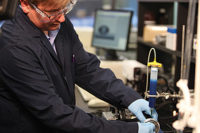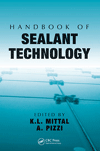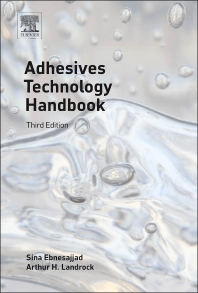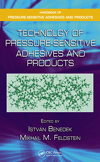An Explosion-Proof UV-Curable Sealant System
UV-curable sealant systems are an innovative solution for the production of ammunition cartridges.

Ultraviolet (UV)-curable adhesives and sealants have been used successfully in numerous applications due to their excellent high-strength bonding to a variety of substrates, as well as their aesthetically pleasing finish. Their quick curing times are ideal for high-speed, high-volume production lines.
In such demanding production lines, selecting the appropriate UV-curable sealants, applicators and UV-curing equipment is important for the proper implementation of a UV-curable sealant process. Additional considerations may be necessary in order to comply with specific product safety regulations. Implementing a UV-curable sealant system for a high-speed, high-volume ammunition production line can be challenging, but the benefits outweigh the drawbacks.

A bullet’s manufacturing process begins with the production of each individual component.2 The assembly process loads the propellant into the case and attaches the projectile to the case. The projectile is then sealed into the case by the use of a pitch- or bitumen-based sealant, which is applied to the mouth of the case before “crimping” the projectile or bullet into it. This messy and problematic sealant process typically provides a shelf life of about 10-20 years. Modern advancements in sealants-especially UV-curable sealants-can provide a much better controlled joint and can extend the shelf life to approximately 30-35 years.
In the new age of UV-curable sealants, an ammunition case can be waterproofed by applying a UV-curable sealant to the joint between the brass case and the projectile of an ammunition cartridge after the ammunition cartridge is fully assembled and crimped. The UV-curable sealant penetrates, or “wicks,” into the joint by capillary attraction and is then cured by proper exposure to a UV radiation source.
The completed, sealed ammunition cartridge is then presented to an accept/reject system, and all acceptable cartridges are passed down an out-feed chute to tote carts for packaging. Any reject components are directed to quality assurance personnel for disposal. This type of production process can apply to a variety of cartridges (e.g., 5.45 mm, 5.56 mm, 7.62 mm, .308 cal, .338 cal, .50 cal, 20 mm and 30 mm).

The UV-curing equipment specifications are driven by the UV-curable sealant, production speed, production line specifics, safety and regulatory requirements. The UV-curable sealant usually contains a photoinitiator, which determines the required UV wavelength and minimum UV radiation energy (measured in J/cm2). In a high-speed production line, the required UV power is determined by:
Energy (J/cm2) = Power (W/cm2) x Exposure Time (Seconds)
A higher production rate obviously results in a shorter exposure cycle; therefore, a higher power UV system may be required. For a given UV-curable sealant and production rate, the required UV power may be computed. Additional on-line, at-speed testing may be needed to verify the UV power and proper cure. Alternatively, analytical testing methods may be incorporated to establish the relationship between the sealant cure rate, sealant thickness, UV power, and exposure cycle.3
Due to ever-increasing production throughput, UV equipment is usually challenged to provide the highest possible UV output. The UV radiation output is usually most powerful at the UV lamp aperture. Therefore, a close placement of the UV sources to the cartridges is desired. However, one has to consider and manage the amount of heat transferred from the UV source to the cartridges via radiation, conduction, and convection as a result of this close proximity to the explosive material.
Additional regulatory compliances also need to be considered. For example, UV equipment is generally required to be installed directly on the out-feed end of an ammunition load and assembly machine; these are considered a Class 2 Division 1 Group E, F, and G hazardous environment. (Note: Class 2 refers to ignitable metal, carbon, or organic dust. Division 1 classifies the substance as hazardous under normal conditions. Group E contains aluminum and magnesium alloys; Group F refers to carbon, coke and coal; and Group G includes flour, grain, wood, plastic and chemicals.) Therefore, additional safety considerations should be made for the UV-curing equipment to comply with the required regulatory compliances.
As one may expect, the proper application and UV curing of the sealant is a very important step in the ammunition manufacturing process. The UV-curing process should include an inspection system to examine the complete periphery of the joint for the sealant ring application, placement and continuity. The system should also inspect the proper sealant application for each manufactured cartridge at full production speed.

The UV-curing equipment is usually based on either traditional arc lamps or UV-LED technologies. A careful comparison between these technologies points to UV-LEDs as a more appropriate solution for this application. Arc lamps can be more powerful than UV-LED systems. However, most of the arc lamp optical output is spread through the UVA (315-400 nm), UVB (280-31 nm), UVC (200-280 nm), visible and infrared range of the spectrum.
In general, the photoinitiators in the UV-curable sealant are sensitive to UVA and, in some cases, more sensitive to the small range in the UVA spectrum. Therefore, the electrical-to-UVA optical conversion of arc lamps is not as efficient as UV-LEDs, which have a narrow concentrated UV energy spectrum. In addition, the majority of the electrical power to the arc lamp is converted to heat, which is radiated along with the UV signal. In contrast, UV-LEDs offer electrical-to-optical efficiencies as high as 22%, provide a narrow energy spectrum, and do not radiate any other unwanted signals (e.g., IR or heat) toward the curable material.
The required UV power is determined by the type of UV-curable sealant, as well as the production line speed. Multiple off-the-shelf arc lamp systems may be used to deliver the required UV radiation. However, various analysis and experiments indicate that the cooling of multiple arc lamp systems with close proximity to the material is difficult, expensive, and complex to implement. Therefore, the arc lamp systems have to be placed in cooling cabinets and may require light guides to transfer UV to the cartridges. This introduces additional inefficiencies and possible maintenance issues due to UV solarizations. UV-LED systems, however, may be placed directly next to the cartridge, with simpler cooling systems and without any light guides. In addition, UV-LED systems are easier to control; they can be rapidly switched on and off without damaging the lamp.
Typical arc lamp system lifetimes are in the range of a few hundred to perhaps a thousand hours, while the lifetimes of UV-LED systems are usually of a much higher magnitude. In addition, UV-LED systems typically enjoy a longer life, as they may be switched off when the production line is in stop/go mode. UV-LED systems also reduce downtime and scheduled preventive maintenance because they require less frequent replacement than arc lamp systems. Arc lamps also usually contain toxic material and are not as environmentally friendly as UV-LEDs.
The AccuCure Lightbar from Digital Light Lab provides a narrow, 10 cm focused UV beam that emits an optimized radiation pattern for the UV-curable sealant at the case and projectile joint. To comply with Class 2 Division 1 Group E, F, and G hazardous environment regulation standards, the unit is fitted with a type Z purge and pressurization protection system in the form of a sealed and pressurized enclosure. The system is directly mounted on the production line and minimizes any UV losses.
The AccuCure Lightbar features a modular architecture to enable various production line speeds. For example, multiple units can be cascaded together to provide a longer UV radiation pattern and accommodate higher production throughput. After curing, an automated, vision-based system inspects each cartridge’s joint periphery for the sealant ring application, placement and continuity. The inspection system, which contains a UV light source, high-speed camera, image acquisition, image processing algorithm and processing electronics, can inspect of all of the cartridges synchronized to the production throughput.
The UV source excites the fluorescing material in the sealant, which makes it easier to detect and inspect. Figure 2 shows a UV-excited image of several cartridges with different sealant applications.
For additional information, contact the authors at:
2. Bames, Frank C., Cartridges of the World, 6th ed, DBI Books, Inc., 1989.
3. Dao, Tien, Roye, Nick, Hedman, Kaj, Dehkordi, Peyman, “The Effect of UV Intensity on the Cure Profiles of Developing Networks, A Case Study for Determining Optimized UV Curing Intensity,” RadTech Report, p. 15, July/August 2009.

Ultraviolet (UV)-curable adhesives and sealants have been used successfully in numerous applications due to their excellent high-strength bonding to a variety of substrates, as well as their aesthetically pleasing finish. Their quick curing times are ideal for high-speed, high-volume production lines.
In such demanding production lines, selecting the appropriate UV-curable sealants, applicators and UV-curing equipment is important for the proper implementation of a UV-curable sealant process. Additional considerations may be necessary in order to comply with specific product safety regulations. Implementing a UV-curable sealant system for a high-speed, high-volume ammunition production line can be challenging, but the benefits outweigh the drawbacks.

Figure 1. Various Sized Cartridges and Their Components.
Background
The history of bullets dates back thousands of years, when cast lead bullets were used with slings. The modern bullet’s history begins sometime after 1249, when gunpowder was used to fire projectiles from the open end of a tube. Modern small arms ammunitions, or cartridges, are used in a variety of firearms ranging from pistols and shotguns to rifles and heavier automatic weapons (such as machine guns).1 The term “bullet” is loosely used to describe the cartridge, but it mainly refers to the actual projectile. The proper components and terminology are projectile, case, primer, and propellant or gunpowder, as shown in Figure 1.A bullet’s manufacturing process begins with the production of each individual component.2 The assembly process loads the propellant into the case and attaches the projectile to the case. The projectile is then sealed into the case by the use of a pitch- or bitumen-based sealant, which is applied to the mouth of the case before “crimping” the projectile or bullet into it. This messy and problematic sealant process typically provides a shelf life of about 10-20 years. Modern advancements in sealants-especially UV-curable sealants-can provide a much better controlled joint and can extend the shelf life to approximately 30-35 years.
In the new age of UV-curable sealants, an ammunition case can be waterproofed by applying a UV-curable sealant to the joint between the brass case and the projectile of an ammunition cartridge after the ammunition cartridge is fully assembled and crimped. The UV-curable sealant penetrates, or “wicks,” into the joint by capillary attraction and is then cured by proper exposure to a UV radiation source.
The completed, sealed ammunition cartridge is then presented to an accept/reject system, and all acceptable cartridges are passed down an out-feed chute to tote carts for packaging. Any reject components are directed to quality assurance personnel for disposal. This type of production process can apply to a variety of cartridges (e.g., 5.45 mm, 5.56 mm, 7.62 mm, .308 cal, .338 cal, .50 cal, 20 mm and 30 mm).

Figure 2. Excited Cartridge with Various Sealant Applications
Challenges
Modern high-speed ammunition production lines can operate at production rates in excess of 150 cartridges per minute. Several challenges are associated with the UV-curable sealant process for such a high-speed production line. These challenges can be grouped into the following categories:- Selection and application of the UV-curable sealant
- Specification and implementation of the UV-curing system
- Verification of sealant application and UV curing
The UV-curing equipment specifications are driven by the UV-curable sealant, production speed, production line specifics, safety and regulatory requirements. The UV-curable sealant usually contains a photoinitiator, which determines the required UV wavelength and minimum UV radiation energy (measured in J/cm2). In a high-speed production line, the required UV power is determined by:
Energy (J/cm2) = Power (W/cm2) x Exposure Time (Seconds)
A higher production rate obviously results in a shorter exposure cycle; therefore, a higher power UV system may be required. For a given UV-curable sealant and production rate, the required UV power may be computed. Additional on-line, at-speed testing may be needed to verify the UV power and proper cure. Alternatively, analytical testing methods may be incorporated to establish the relationship between the sealant cure rate, sealant thickness, UV power, and exposure cycle.3
Due to ever-increasing production throughput, UV equipment is usually challenged to provide the highest possible UV output. The UV radiation output is usually most powerful at the UV lamp aperture. Therefore, a close placement of the UV sources to the cartridges is desired. However, one has to consider and manage the amount of heat transferred from the UV source to the cartridges via radiation, conduction, and convection as a result of this close proximity to the explosive material.
Additional regulatory compliances also need to be considered. For example, UV equipment is generally required to be installed directly on the out-feed end of an ammunition load and assembly machine; these are considered a Class 2 Division 1 Group E, F, and G hazardous environment. (Note: Class 2 refers to ignitable metal, carbon, or organic dust. Division 1 classifies the substance as hazardous under normal conditions. Group E contains aluminum and magnesium alloys; Group F refers to carbon, coke and coal; and Group G includes flour, grain, wood, plastic and chemicals.) Therefore, additional safety considerations should be made for the UV-curing equipment to comply with the required regulatory compliances.
As one may expect, the proper application and UV curing of the sealant is a very important step in the ammunition manufacturing process. The UV-curing process should include an inspection system to examine the complete periphery of the joint for the sealant ring application, placement and continuity. The system should also inspect the proper sealant application for each manufactured cartridge at full production speed.

The AccuCure Lightbar provides a narrow, 10cm focused UV beam that emits an optimized radiation pattern for the UV-curable sealant at the case and projectile joint.
Solutions
The application of the sealant is performed at the “sealant apply” station, which consists of a precision, pneumatically operated, normally closed pinch valve. The precision dispensing valve features micrometer control over flow (the amount the valve opens and closes), ensuring the accuracy and repeatability of operation. The precision valve is connected to a 1-liter pressurized reservoir that holds the sealant in its own container; no cleaning is required during sealant fill. The production of a shot size with a time/pressure dispensing system has four requirements:- The period and accuracy of the time the valves are “opened”
- Repeatability of the pressure on the material in the reservoir
- Repeatability of the pressure supplied to the valves
- Controlled viscosity of the sealant
The UV-curing equipment is usually based on either traditional arc lamps or UV-LED technologies. A careful comparison between these technologies points to UV-LEDs as a more appropriate solution for this application. Arc lamps can be more powerful than UV-LED systems. However, most of the arc lamp optical output is spread through the UVA (315-400 nm), UVB (280-31 nm), UVC (200-280 nm), visible and infrared range of the spectrum.
In general, the photoinitiators in the UV-curable sealant are sensitive to UVA and, in some cases, more sensitive to the small range in the UVA spectrum. Therefore, the electrical-to-UVA optical conversion of arc lamps is not as efficient as UV-LEDs, which have a narrow concentrated UV energy spectrum. In addition, the majority of the electrical power to the arc lamp is converted to heat, which is radiated along with the UV signal. In contrast, UV-LEDs offer electrical-to-optical efficiencies as high as 22%, provide a narrow energy spectrum, and do not radiate any other unwanted signals (e.g., IR or heat) toward the curable material.
The required UV power is determined by the type of UV-curable sealant, as well as the production line speed. Multiple off-the-shelf arc lamp systems may be used to deliver the required UV radiation. However, various analysis and experiments indicate that the cooling of multiple arc lamp systems with close proximity to the material is difficult, expensive, and complex to implement. Therefore, the arc lamp systems have to be placed in cooling cabinets and may require light guides to transfer UV to the cartridges. This introduces additional inefficiencies and possible maintenance issues due to UV solarizations. UV-LED systems, however, may be placed directly next to the cartridge, with simpler cooling systems and without any light guides. In addition, UV-LED systems are easier to control; they can be rapidly switched on and off without damaging the lamp.
Typical arc lamp system lifetimes are in the range of a few hundred to perhaps a thousand hours, while the lifetimes of UV-LED systems are usually of a much higher magnitude. In addition, UV-LED systems typically enjoy a longer life, as they may be switched off when the production line is in stop/go mode. UV-LED systems also reduce downtime and scheduled preventive maintenance because they require less frequent replacement than arc lamp systems. Arc lamps also usually contain toxic material and are not as environmentally friendly as UV-LEDs.
The AccuCure Lightbar from Digital Light Lab provides a narrow, 10 cm focused UV beam that emits an optimized radiation pattern for the UV-curable sealant at the case and projectile joint. To comply with Class 2 Division 1 Group E, F, and G hazardous environment regulation standards, the unit is fitted with a type Z purge and pressurization protection system in the form of a sealed and pressurized enclosure. The system is directly mounted on the production line and minimizes any UV losses.
The AccuCure Lightbar features a modular architecture to enable various production line speeds. For example, multiple units can be cascaded together to provide a longer UV radiation pattern and accommodate higher production throughput. After curing, an automated, vision-based system inspects each cartridge’s joint periphery for the sealant ring application, placement and continuity. The inspection system, which contains a UV light source, high-speed camera, image acquisition, image processing algorithm and processing electronics, can inspect of all of the cartridges synchronized to the production throughput.
The UV source excites the fluorescing material in the sealant, which makes it easier to detect and inspect. Figure 2 shows a UV-excited image of several cartridges with different sealant applications.
High-Speed Success
High-speed ammunition production systems based on UV-curable sealants and UV-LED curing systems are already in use in full production settings. A UV-curable sealant, accurate dispensing, UV-LEDs, and automated-inspection technologies-coupled with innovative designs-are the key enablers for the success of these systems in ammunition production lines.For additional information, contact the authors at:
- Digital Light Lab, 9041 Executive Park Dr., Suite 100, Knoxville, TN, 37923; phone (865) 694 -7892; fax (615) 523-1430; email dehkordi@digitallightlab.com; or visit www.digitallightlab.com.
- Lennox-Gentle Automation, 400 Corporate Circle, Suite C, Golden, CO 80401; phone (303) 762-0500; email john@lgautomation.com; or visit www.lgautomation.com.
References
1. Hakley, F.W., History of Modern U.S. Military Small Arms Ammunition, Macmillan, 1967.2. Bames, Frank C., Cartridges of the World, 6th ed, DBI Books, Inc., 1989.
3. Dao, Tien, Roye, Nick, Hedman, Kaj, Dehkordi, Peyman, “The Effect of UV Intensity on the Cure Profiles of Developing Networks, A Case Study for Determining Optimized UV Curing Intensity,” RadTech Report, p. 15, July/August 2009.
Links
Looking for a reprint of this article?
From high-res PDFs to custom plaques, order your copy today!






